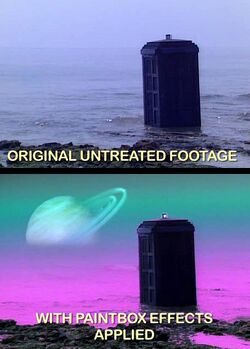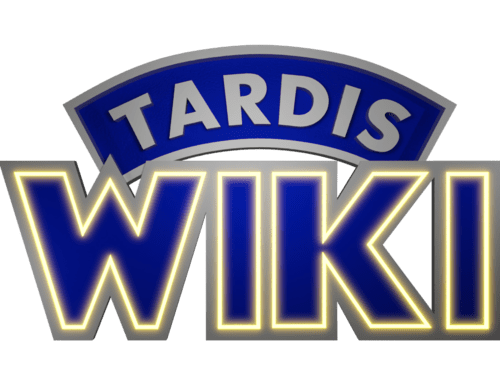Quantel Paintbox: Difference between revisions
m (moved Paintbox to Quantel Paintbox: moving to formal name, but having a redirect at Paintbox is quite useful.) |
mNo edit summary |
||
| Line 1: | Line 1: | ||
{{real world}} | {{real world}} | ||
[[file:Paintbox.jpg|250px|thumb|right|A demonstration of what Paintbox could do. ([[DOC]]: ''[[The Making of The Trial of a Time Lord: Part Two - Mindwarp|The Making of . . . Mindwarp]]'']] | [[file:Paintbox.jpg|250px|thumb|right|A demonstration of what Paintbox could do. ([[DOC]]: ''[[The Making of The Trial of a Time Lord: Part Two - Mindwarp|The Making of . . . Mindwarp]]'']] | ||
The '''{{PAGENAME}}''', or simply '''Paintbox''', was a graphics workstation which revolutionised the way television graphics were produced in the [1980s]]. Typically of greatest utility to sports and news programming, Paintbox was occasionally repurposed by the [[British Broadcasting Corporation]] and used for dramatic and entertainment programming as well. ''[[Doctor Who]]'' was one of the system's earliest and most enthusiastic adopters in the BBC's Drama Series department. | The '''{{PAGENAME}}''', or simply '''Paintbox''', was a graphics workstation which revolutionised the way television graphics were produced in the [[1980s]]. Typically of greatest utility to sports and news programming, Paintbox was occasionally repurposed by the [[British Broadcasting Corporation]] and used for dramatic and entertainment programming as well. ''[[Doctor Who]]'' was one of the system's earliest and most enthusiastic adopters in the BBC's Drama Series department. | ||
Though mainly used to superimpose things like [[wikipedia:lower third|lower third]]s and other textual elements, it could be used to superimpose anything on any part of the picture. Paintbox also allowed for an early form of [[colourist|colour grading]]. Though many of the [[serial]]s in the [[Sixth Doctor|Sixth]] and [[Seventh Doctor]]s' eras used Paintbox to varying degrees, one of the stories to make obvious use of the technology was ''[[Mindwarp]]''. [[The Making of The Trial of a Time Lord: Part Two - Mindwarp|Its "making of" documentary]] demonstrated the effects that Paintbox could accomplish in the mid-1980s. | Though mainly used to superimpose things like [[wikipedia:lower third|lower third]]s and other textual elements, it could be used to superimpose anything on any part of the picture. Paintbox also allowed for an early form of [[colourist|colour grading]]. Though many of the [[serial]]s in the [[Sixth Doctor|Sixth]] and [[Seventh Doctor]]s' eras used Paintbox to varying degrees, one of the stories to make obvious use of the technology was ''[[Mindwarp]]''. [[The Making of The Trial of a Time Lord: Part Two - Mindwarp|Its "making of" documentary]] demonstrated the effects that Paintbox could accomplish in the mid-1980s. | ||
Revision as of 21:56, 26 June 2011
The Quantel Paintbox, or simply Paintbox, was a graphics workstation which revolutionised the way television graphics were produced in the 1980s. Typically of greatest utility to sports and news programming, Paintbox was occasionally repurposed by the British Broadcasting Corporation and used for dramatic and entertainment programming as well. Doctor Who was one of the system's earliest and most enthusiastic adopters in the BBC's Drama Series department.
Though mainly used to superimpose things like lower thirds and other textual elements, it could be used to superimpose anything on any part of the picture. Paintbox also allowed for an early form of colour grading. Though many of the serials in the Sixth and Seventh Doctors' eras used Paintbox to varying degrees, one of the stories to make obvious use of the technology was Mindwarp. Its "making of" documentary demonstrated the effects that Paintbox could accomplish in the mid-1980s.

